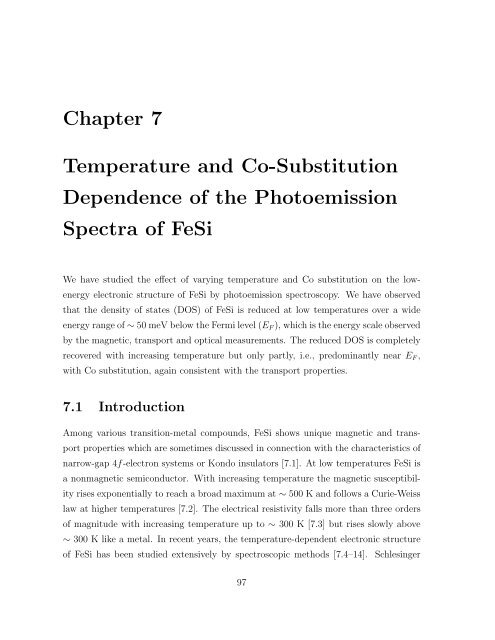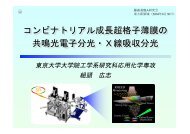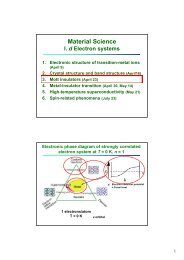Thesis High-Resolution Photoemission Study of Kondo Insulators ...
Thesis High-Resolution Photoemission Study of Kondo Insulators ...
Thesis High-Resolution Photoemission Study of Kondo Insulators ...
Create successful ePaper yourself
Turn your PDF publications into a flip-book with our unique Google optimized e-Paper software.
Chapter 7<br />
Temperature and Co-Substitution<br />
Dependence <strong>of</strong> the <strong>Photoemission</strong><br />
Spectra <strong>of</strong> FeSi<br />
We have studied the effect <strong>of</strong> varying temperature and Co substitution on the lowenergy<br />
electronic structure <strong>of</strong> FeSi by photoemission spectroscopy. We have observed<br />
that the density <strong>of</strong> states (DOS) <strong>of</strong> FeSi is reduced at low temperatures over a wide<br />
energy range <strong>of</strong> ∼ 50 meV below the Fermi level (EF ), which is the energy scale observed<br />
by the magnetic, transport and optical measurements. The reduced DOS is completely<br />
recovered with increasing temperature but only partly, i.e., predominantly near EF ,<br />
with Co substitution, again consistent with the transport properties.<br />
7.1 Introduction<br />
Among various transition-metal compounds, FeSi shows unique magnetic and transport<br />
properties which are sometimes discussed in connection with the characteristics <strong>of</strong><br />
narrow-gap 4f-electron systems or <strong>Kondo</strong> insulators [7.1]. At low temperatures FeSi is<br />
a nonmagnetic semiconductor. With increasing temperature the magnetic susceptibility<br />
rises exponentially to reach a broad maximum at ∼ 500 K and follows a Curie-Weiss<br />
law at higher temperatures [7.2]. The electrical resistivity falls more than three orders<br />
<strong>of</strong> magnitude with increasing temperature up to ∼ 300 K [7.3] but rises slowly above<br />
∼ 300 K like a metal. In recent years, the temperature-dependent electronic structure<br />
<strong>of</strong> FeSi has been studied extensively by spectroscopic methods [7.4–14]. Schlesinger<br />
97






